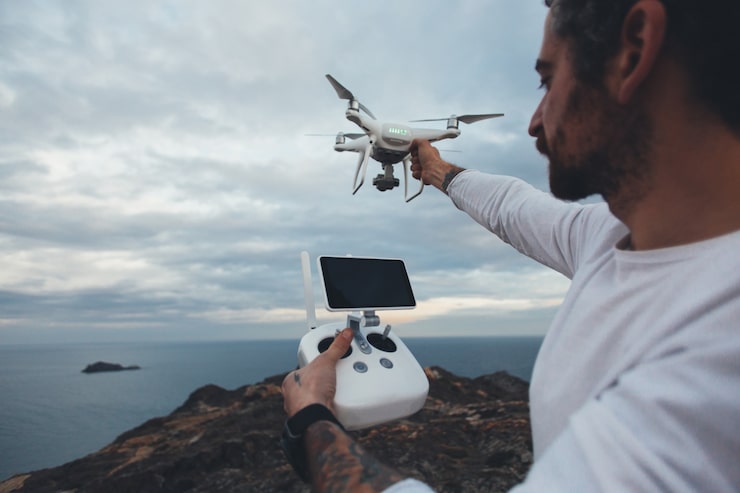Drone technology trends are transforming industries in ways that were unimaginable a decade ago. From agriculture and construction to defense and entertainment, drones are pushing boundaries and creating innovative solutions. Their rapid adoption demonstrates how advanced technologies like AI, machine learning, and automation are fueling a revolution.
In recent years, drones have evolved from hobbyist gadgets into essential tools for businesses and governments worldwide. These advancements are not only improving efficiency but also reshaping how people perceive technology in daily life.
Evolution of Drone Technology
The journey of drones began with simple radio-controlled aircraft used for military training. Over time, improvements in GPS, sensors, and lightweight materials expanded their potential. Today, modern drones are equipped with sophisticated cameras, AI-powered navigation systems, and obstacle detection features.
This shift has redefined drones from mere flying devices into intelligent machines capable of performing critical tasks. The evolution of drones reflects the broader impact of drone technology trends on society, industry, and innovation.
Drone Technology Trends in Agriculture
Farmers are increasingly turning to drones for precision agriculture. With the help of aerial imagery and AI analysis, drones can monitor crop health, assess soil conditions, and optimize irrigation systems. By providing real-time data, drones enable farmers to reduce costs, boost yields, and practice sustainable farming.
For example, a farm in India implemented drones to spray fertilizers more efficiently, cutting labor costs by nearly half. Such real-life stories highlight how drone technology trends are addressing challenges in global food production.
Drone Use in Construction and Infrastructure
Construction companies have embraced drones to improve safety, speed, and accuracy. Aerial surveys can create 3D maps of construction sites, monitor progress, and detect potential safety hazards. Drones also help in inspecting hard-to-reach areas like rooftops, bridges, and tunnels.
These applications not only save time but also reduce workplace risks. Many projects now rely heavily on drone-generated data to make informed decisions, proving how the construction industry benefits from emerging drone innovations.
Surveillance and Security Applications
Security agencies worldwide rely on drones for crowd monitoring, traffic management, and disaster response. Drones equipped with infrared cameras can provide critical insights during search-and-rescue missions. Law enforcement agencies use them for real-time surveillance during large events, ensuring safety with minimal human risk.
This practical use of drone technology trends showcases their value in protecting lives and assets while cutting operational costs.
Drone Technology Trends in Delivery Services
One of the most exciting advancements is the use of drones in logistics and delivery. Companies like Amazon and UPS are experimenting with drone fleets to deliver packages quickly and efficiently. These autonomous delivery systems promise reduced carbon footprints and faster service, especially in urban and remote areas.
Although regulatory hurdles remain, the vision of drone-based delivery is becoming a reality, reshaping the future of e-commerce and customer convenience.
Impact on Entertainment and Media
The film and entertainment industry has embraced drones for breathtaking aerial shots. Directors and producers no longer need helicopters or cranes for high-angle filming. Instead, lightweight drones equipped with 4K cameras can capture stunning visuals at a fraction of the cost.
Sports broadcasting has also been revolutionized, with drones offering immersive perspectives during live matches. These developments highlight how drone technology trends are influencing creativity and storytelling.
Drone Role in Disaster Management
During natural disasters, drones are deployed to survey affected areas, deliver medical supplies, and locate survivors. Their ability to fly into dangerous environments makes them invaluable in emergency response. For example, during floods in Southeast Asia, drones provided crucial mapping data that guided relief efforts and saved lives.
By integrating drones into disaster management strategies, governments and NGOs can act faster and more effectively in times of crisis.
Military and Defense Applications
The origins of drones in military use continue to expand with new technological developments. Defense drones are now equipped with advanced surveillance systems, autonomous navigation, and AI-driven target recognition. These machines reduce risks to soldiers and provide a significant tactical advantage.
While ethical debates surround their use, there is no denying that drone technology trends in defense are reshaping modern warfare strategies.
Integration of AI and Automation
Artificial intelligence is at the heart of modern drone innovation. AI-powered drones can analyze environments, avoid obstacles, and even predict potential hazards. Automation allows them to perform tasks like surveying, mapping, and delivery with minimal human intervention.
For example, AI drones are used in wildlife conservation to monitor endangered species without disturbing natural habitats. This fusion of AI and drones demonstrates the limitless possibilities of technological synergy.
Environmental and Conservation Efforts
Drones play a vital role in environmental protection. Conservationists use them to track deforestation, monitor wildlife, and measure pollution levels. Lightweight drones can reach remote areas, providing valuable insights for ecological studies.
These applications highlight how drone technology trends contribute positively to sustainability, balancing industrial growth with environmental responsibility.
Future Outlook of Drone Technology
The future of drones looks promising, with experts predicting greater integration into daily life. From personal transportation drones to fully automated delivery systems, the possibilities are vast. Regulatory frameworks are evolving to ensure safety and efficiency while encouraging innovation.
Investments in research and development continue to grow, and as technology advances, drones are likely to become more affordable, smarter, and widely adopted.
Read also:
uruguayaans voetbalelftal – braziliaans voetbalelftal opstellingen
argentina national football team vs belgium national football team lineups
england national football team vs brazil national football team lineups
mexico vs honduras 2022

